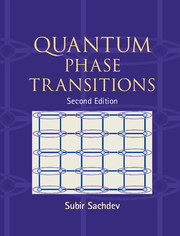Preface to the second edition
Published online by Cambridge University Press: 16 May 2011
Summary
Research on quantum phase transitions has undergone a vast expansion since the publication of the first edition, over a decade ago. Many new theoretical ideas have emerged, and the arena of experimental systems has grown rapidly. The cuprates have been firmly established to be d-wave superconductors, with a massless Dirac spectrum for their electronic excitations; the latter spectrum has also been observed in graphene and on the surface of topological insulators. Such fermions play a key role in a variety of quantum phase transitions. The observation of quantum oscillations in the presence of strong magnetic fields in the underdoped cuprates has highlighted the relevance of competing orders, and their quantum critical points. Optical lattices of ultracold atoms now offer a realization of the boson Hubbard model, and exhibit the superfluid–insulator transition. And ideas on quantum criticality and entanglement have had an interesting interplay with developments in quantum information science.
The second edition does not present a fully comprehensive survey of these ongoing developments. I believe the core topics of the first edition had a certain coherence, and they continue to be central to the more modern developments; I did not wish to dilute the global perspective they offer in understanding both condensed matter and ultracold atom experiments. However, wherever possible, I have discussed important advances, or directed the reader to review articles.
- Type
- Chapter
- Information
- Quantum Phase Transitions , pp. xvii - xviiiPublisher: Cambridge University PressPrint publication year: 2011



